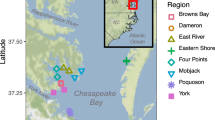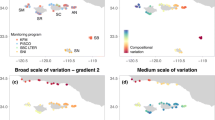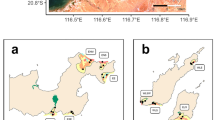Abstract
The spatial arrangement of seagrass beds varies from scales of centimeters to meters (rhizomes, shoot groups), meters to tens of meters (patches), to tens of meters to kilometers (seagrass landscapes). In this study we examine the role of patch scale (patch size, seagrass % cover, seagrass biomass), landscape scale (fractal geometry, patch isolation) and wave exposure (mean wind velocity and exceedance) variables in influencing benthic community composition in seagrass beds at three intertidal sites in northern New Zealand (two sites in Manukau Harbour and one site in Whangapoua Harbour). Analysis of univariate community measures (numbers of individuals and species, species richness, diversity and evenness) and multivariate analyses indicated that there were significant differences in community composition inside and outside of seagrass patches at each of the three sites. Partialling out the spatial and temporal components of the ecological variation indicated that seagrass patch variables explained only 3–4% of the patch scale variation in benthic community composition at each of the sites. The temporal component was more important, explaining 12–14% of the variation. The unexplained variation was high (about 75%) at all three sites, indicating that other factors were influencing variation in community composition at the scale of the patches, or that there was a large amount of stochastic variation. Landscape and wave exposure variables explained 62.5% of the variation in the species abundance data, and the unexplained variation at the landscape level was correspondingly low (12%). Canonical correspondence analysis produced an ordination that suggests that, while mean wind velocity and exceedance were important in explaining the differences between the communities in the two harbours, spatial patterning of the habitat, primarily fractal dimension, and secondarily patch isolation (or some factors that were similarly correlated), were important in contributing to variability in community composition at the two sites in Manukau Harbour. This study suggests that spatial patterning of seagrass habitat at landscape scales, independent of the patch scale characteristics of the seagrass beds, can affect benthic community composition. Community composition inside and outside seagrass habitats involves responses to seagrass bed structure at a series of hierarchical levels, and we need to consider more than one spatial scale if we are to understand community dynamics in seagrass habitats.
Similar content being viewed by others
Literature Cited
Bell, J. D. and M. Westoby. 1986. Importance of local changes in leaf height and density to fish and decapods associated with seagrasses. Journal of Experimental Marine Biology and Ecology 104:249–274.
Bell, R. G., T. M. Hume, T. J. Dolphin, M. O. Green, and R. A. Walters. 1997. Characterisation of physical environmental factors on an intertidal sandflat, Manukau Harbour, New Zealand. Journal of Experimental Marine Biology and Ecology 216:11–31.
Bell, S. S., M. O. Hall, and B. D. Robbins. 1995. Toward a landscape approach in seagrass beds: Using macroalgal accumulation to address questions of scale. Oecologia 104:163–168.
Bell, S. S. and G. R. F. Hicks. 1991. Marine landscapes and faunal recruitment: A field test with seagrasses and copepods. Marine Ecology Progress Series 73:61–68.
Borcard, D., P. Legendre, and P. Drapeeau. 1992. Partialling out the spatial component of ecological variation. Ecology 73: 1045–1055.
Buller, A. T. and J. McManus. 1979. Sediment sampling and analysis, p. 87–130. In K. R. Dyer (ed.), Estuarine Hydrography and Sedimentation. A Handbook. Cambridge University Press. Cambridge.
Carr, M. R.. 1996. Primer User Manual: Plymouth Routines in Multivariate Ecological Research. Plymouth Marine Laboratory, United Kingdom.
Chambers, P. A., E. E. Prepas, H. R. Hamilton, and M. L. Bothwell. 1991. Current velocity and its effect on aquatic macrophytes in flowing waters. Ecological Applications 1:249–257.
Clarke, K. R.. 1993. Non-parametric multivariate analyses of changes in community structure. Australian Journal of Ecology 18:117–143.
Clarke, K. R. and R. H. Green. 1988. Statistical design and analysis for a ‘biological effects’ study. Marine Ecology Progress Series 46:213–226.
Clarke, K. R. and R. M. Warwick. 1994. Change in Marine Communities: An Approach to Statistical Analysis and Interpretation. Natural Environment reserch Council. United Kingdom.
Coops, H., R. Boeters, and H. Smit. 1991. Direct and indirect effects of wave attack on helophytes. Aquatic Botany 41:333–352.
den Hartog, C.. 1979. Seagrasses and seagrass ecosystems, an appraisal of the research approach. Aquatic Botany 7:105–117.
Dolphin, T.J., T. M. Hume, and K. E. Parnell. 1995. Oceanographic processes and sediment mixing on a sand flat in an enclosed sea, Manukau Harbour, New Zealand. Marine Geology 128:169–181.
Duarte, C. M., N. Marbá, N. Agawin, J. Cebrián, S. Enríquez, M. D. Fortes, M. E. Gallegos, M. Merino, B. Olesen, K. Sand-Jensen, J. Uri, and J. Vermaat. 1994. Reconstruction of seagrass dynamics: Age determinations and associated tools for the seagrass ecologist. Marine Ecology Progress Series 107: 195–209.
Duarte, C. M. and K. Sand-Jensen. 1990a. Seagrass colonization: Patch formation and patch growth in Cymodocea nodosa. Marine Ecology Progress Series 65:193–200.
Duarte, C. M. and K. Sand-Jensen. 1990b. Seagrass colonization: Biomass development and shoot demography in Cymodocea nodosa patches. Marine Ecology Progress Series 67:97–103.
Eckman, J. E.. 1987. The role of hydrodynamics in recruitment, growth, and survival of Argopecten irradians (L.) and Anomia simplex (D'Orbigny) within eelgrass meadows. Journal of Experimental Marine Biology and Ecology 106:165–191.
Farmer, A. M., and M. S. Adams. 1989. A consideration of the problems of scale in the study of the ecology of aquatic macrophytes. Aquatic Botany 33:177–189.
Farmer, A. M., and M. S. Adams. 1991. The nature of scale and the use of hierarchy theory in understanding the ecology of aquatic macrophytes. Aquatic Botany 41:253–261.
Field, J. G., K. R. Clarke, and R. M. Warwick. 1982. A practical strategy for analysing multispecies distribution patterns. Marine Ecology Progress Series 8:37–52.
Fonseca, M. S.. 1996. Scale dependence in the study of seagrass systems, p. 95–104. In J. Kuo, R. C. Phillips, D. I. Walker, and H. Kirkman (eds.), Seagrass Biology: Proceedings of an International Workshop. University of Western Australia. Perth.
Fonseca, M. S. and S. S. Bell. 1998.Influence of physical settings on seagrass landscapes near Beaufort, North Carolina, USA. Marine Ecology Progress Series 171:109–121.
Fonseca, M. S. and W. J. Kenworthy 1987. Effects of current on photosynthesis and distribution of seagrasses. Aquatic Botany 27:59–78.
Fonseca, M. S., J. C. Zieman, G. W. Thayer, and J. S. Fisher. 1983. The role of current velocity in structuring eelgrass (Zostera marina L.) meadows. Estuarine, Coastal and Shelf Science 17:367–380.
Forman, R. T. T., and M. Godron. 1981. Patches and structural components for a landscape ecology. BioScience 31:733–740.
Franklin, J. F. and R. T. T. Forman. 1987. Creating landscape patterns by forest cutting: Ecological consequences and principles. Landscape Ecology 1:5–18.
Grant, J., S. J. Turner, P. Legendre T. M. Hume, and R. G. Bell. 1997. Patterns of sediment reworking and transport over small spatial scales on an intertidal sandflat, Manukau Harbour, New Zealand. Journal of Experimental Marine Biology and Ecology 216:33–50.
Harrison, P. G. 1982. Spatial and temporal patterns in abundance of two intertidal seagrasses, Zostera americana Den Hartog and Zostera marina L. Aquatic Botany 12:305–320.
Henriques, P. R. 1980. Faunal community structure of eight soft shore, intertidal habitats in the Manukau Harbour. New Zealand Journal of Ecology 3:97–103.
Hewitt, J. E., G. B. McBride, R. D. Pridmore, and S. F. Thrush. 1993. Patchy distributions: Optimising sample size. Environmental Monitoring and Assessment 27:95–105.
Hewitt, J. E., S. F. Thrush, V. J. Cummings, and S. J. Turner. 1998. The effect of changing sampling scales on our ability to detect effects of large-scale processes on communities. Journal of Experimental Marine Biology and Ecology 227:251–254.
Hoekstra, T. W., T. F. H. Allen, and C. H. Flather. 1991. Implicit scaling in ecological research. On when to make studies of mice and men. BioScience 41:148–154.
Irlandi, E. A. 1994. Large- and small-scale effects of habitat structure on rates of predation: How percent coverage of seagrass affects rates of predation and siphon nipping on an infaunal bivalve. Oecologia 98:176–183.
Irlandi, E. A. 1996. The effects of seagrass patch size and energy regime on growth of a suspension-feeding bivalve. Journal of Marine Research 54:161–185.
Irlandi, E. A., W. G. Ambrose, and B. A. Orlando 1995. Landscape ecology and the marine environment: How spatial configuration of seagrass habitat influences growth and survival of the bay scallop. Oikos 72:307–313.
Irlandi, E. A. and C. H. Peterson. 1991. Modification of animal habitat by large plants: Mechanisms by which seagrasses influence clam growth. Oecologia 87:307–318.
Keddy, P. A. 1982. Quantifying within-lake gradients of wave energy: Interrelationships of wave energy, substrate particle size and shoreline plants in Axe Lake, Ontario. Aquatic Botany 14: 41–58.
Kirkman, H. and J. Kuo. 1990. Pattern and process in southern Western Australian seagrasses. Aquatic Botany 37:367–382.
Kotliar, N. B. and J. A. Wiens. 1990. Multiple scales of patchiness and patch structure: A hierarchical framework for the study of heterogeneity. Oikos 59:253–260.
Krummel, J. R., R. H. Gardner, G. Sugihara, R. V. O'Neill, and P. R. Coleman. 1987. Landscape patterns in a disturbed environment. Oikos 48:321–324.
Lovejoy, S. 1982. Area-perimeter relation for rain and cloud areas. Science 216:185–187.
Madsen, J. D. 1991. Resource allocation at the individual plant level. Aquatic Botany 41:67–86.
Marbà, N., J. Cebrián, S. Enríquez, and C. M. Duarte 1994. Migration of large-scale subaqueous bedforms measured with seagrasses (Cymodocea nodosa) as tracers. Limnology and Oceanography 39:126–133.
Marbà, N. and C. M. Duarte. 1995. Coupling of seagrass (Cymodocea nodosa) patch dynamics to subaqueous dune migration. Journal of Ecology 83:381–389.
Milne, B. T. 1988. Measuring the fractal geometry of landscapes. Applied Mathematics and Computation 27:67–79.
Murphey, P. E. and M. S. Fonseca. 1995. Role of high and low energy seagrass beds as nursery areas for Panaeus duorarum in North Carolina. Marine Ecology Progress Series 121:91–98.
Olesen, B. and K. Sand-Jensen. 1994. Patch dynamics of eelgrass Zostera marina. Marine Ecology Progress Series 106:147–156.
O'Neill, R. V., A. R. Johnson, and A. W. King. 1989. A hierarchical framework for the analysis of scale. Landscape Ecology 3:193–205.
O'Neill, R. V., J. R. Krummel, R. H. Gardner, G. Sugihara, B. Jackson, D. L. DeAngelis, B. T. Milne, M. G. Turner, B. Zygmunt, S. W. Christensen, V. H. Dale, and R. L. Graham. 1988. Indices of landscape pattern. Landscape Ecology 1:153–162.
Orth, R. J., K. L. Heck, and J. van Montfrans. 1984. Faunal communities in seagrass beds: A review of the influence of plant structure and prey characteristics on predator-prey relationships. Estuaries 7:339–350.
Peterson, C. H. 1986. Enhancement of Mercenaria mercenaria densities in seagrass beds: Is pattern fixed during settlement season or altered by subsequent differential survival?. Limnology and Oceanography 31:200–205.
Pinel-Alloul, B., T. Niyonsenga, and P. Legendre. 1995. Spatial and environmental components of freshwater zooplankton structure. Ecoscience 2:1–19.
Robbins, B. D. and S. S. Bell. 1994. Seagrass landscapes: A terrestrial approach to the marine subtidal environment. Trends in Ecology and Evolution 9:301–304.
Roper, D. S., R. D. Pridmore, and S. F. Thrush. 1992. Recruitment to the macrobenthos of Macomona liliana (Bivalvia: Tellinidae) in Manukau Harbour, New Zealand. New Zealand Journal of Marine and Freshwater Research 26:385–392.
Schneider, D. C. 1994. Quantitative Ecology: Spatial and Temporal Scaling. Academic Press, San Diego.
Smith, T. and M. Huston. 1989. A theory of the spatial and temporal dynamics of plant communities. Vegelatio 83:49–69.
ter Braak, C. J. F. 1986. Canonical correspondence analysis: A new eigenvector technique for multivariate direct gradient analysis. Ecology 67:1167–1179.
ter Braak, C. J. F. 1988. CANOCO—a FORTRAN program for canonical community ordination by [partial] [detrended] [canonical] correspondence analysis, principle components analysis and redundancy analysis (Version 2.1). Groep Landbouwwiskunde, Ministerie van Landbouw en Visserij, Directoraat-Generaal Landbouw en Voedselvoorziening, Directie Landbouwkundig Onderzoek, Technical Report LWA-88-02.
ter Braak, C. J. F. 1990. Update Notes: CANOCO Version 3.10. Agricultural Mathematics Group. Wageningen, Netherlands.
Thrush, S. F., D. C. Schneider, P. Legendre, R. B. Whitlatch, P. K. Dayton, J. E. Hewitt, A. H. Hines, V. J. Cummings, S. M. Lawrie, J. Grant, R. D. Pridmore, S. J. Turner, and B. H. McArdle. 1997. Scaling-up from experiments to complex ecological systems: Where to next? Journal of Experimental Marine Biology and Ecology 216:243–254.
Tonn, W. M., J. J. Magnuson, M. Rask, and J. Toivonen. 1990. Intercontinental comparison of small-lake fish assemblages: The balance between local and regional processes. American Naturalist 136:345–375.
Turner, M. G. 1989. Landscape ecology: The effect of pattern on process. Annual Review of Ecology and Systematics 20:171–197.
Turner, S. J., J. Grant, R. D. Pridmore, J. E. Hewitt, M. R. Wilkinson, T. M. Hume, and D. J. Morrisey. 1997. Bedload and water-column transport and colonization processes by post-settlement benthic macrofauna: Does infaunal density matter? Journal of Experimental Marine Biology and Ecology 216:51–75.
Turner, S. J., S. F. Thrush, R. D. Pridmore, J. E. Hewitt, V. J. Cummings, and M. Maskery. 1995. Are soft-sediment communities stable? An example from a windy harbour. Marine Ecology Progress Series 120:219–230.
Turner, S. J., S. F. Thrush, M. R. Wilkinson, J. E. Hewitt, V. J. Cummings, A.-M. Schwarz, D. J. Morrisey, and I. Hawes. 1996. Patch dynamics of the seagrass Zostera novazelandica (?) at three sites in New Zealand, p. 21–31. In J. Kuo, D. I. Walker, and H. Kirkman (eds.) Seagrass Biology: Scientific Discussion from an International Workshop. University of Western Australia. Perth.
Urban, D. L., R. V. O'Neill, and H. H. Shugart. 1987. Landscape ecology. A hierarchical perspective can help scientists understand spatial patterns. BioScience 37:119–127.
Veitch, C. R. 1978. Waders of the Manukau Harbour and Firth of Thames. Notornis—Journal of the Ornithological Society of New Zealand (Inc.) 25:1–24.
Walker, D. I., T. J. B. Carruthers, P. F. Morrison, and A. J. McComb. 1996. Experimental manipulation of canopy density in a temperate seagrass [Amphibolis griffithii (Black) den Hartog] meadow: Effects on sediments, p. 117–122. In J. Kuo, R. C. Phillips, D. I. Walker, and H. Kirkman (eds.) Seagrass Biology: Proceedings of an International Workshop. University of Western Australia. Perth.
Warwick, R. M., K. R. Clarke, and J. M. Gee. 1990. The effect of disturbance by soldier crabs Mictyris platycheles H. Milne Edwards on meiobenthic community structure. Journal of Experimental Marine Biology and Ecology 135:19–33.
Wiens, J. A. 1989. Spatial scale in ecology. Functional Ecology 3:385–397.
Wiens, J. A., C. S. Crawford, and J. R. Gosz. 1985. Boundary dynamics: A conceptual framework for studying landscape ecosystems. Oikos 45:421–427.
Wiens, J. A. and B. T. Milne. 1989. Scaling of ‘landscapes’ in landscape ecology, or, landscape ecology from a beetle's perspective. Landscape Ecology 3:87–96.
Williamson, M. H. and J. H. Lawton. 1991. Fractal geometry of ecological habitats, p. 69–86. In S. S. Bell, E. D. McCoy, and H. R. Mushinsky (eds.) Habitat Structure. The Physical Arrangement of Objects in Space. Chapman and Hall. London.
Wilson, F. S. 1990. Temporal and spatial patterns of settlement: A field study of molluscs in Bogue Sound, North Carolina. Journal of Experimental Marine Biology and Ecology 139:201–220.
Sources of Unpublished Materials
Kuo, J. University of Western Australia, Perth, Western Australia. Nelson, W. Museum of New Zealand, Wellington, New Zealand.
Author information
Authors and Affiliations
Rights and permissions
About this article
Cite this article
Turner, S.J., Hewitt, J.E., Wilkinson, M.R. et al. Seagrass patches and landscapes: The influence of wind-wave dynamics and hierarchical arrangements of spatial structure on macrofaunal seagrass communities. Estuaries 22, 1016–1032 (1999). https://doi.org/10.2307/1353080
Received:
Accepted:
Issue Date:
DOI: https://doi.org/10.2307/1353080




